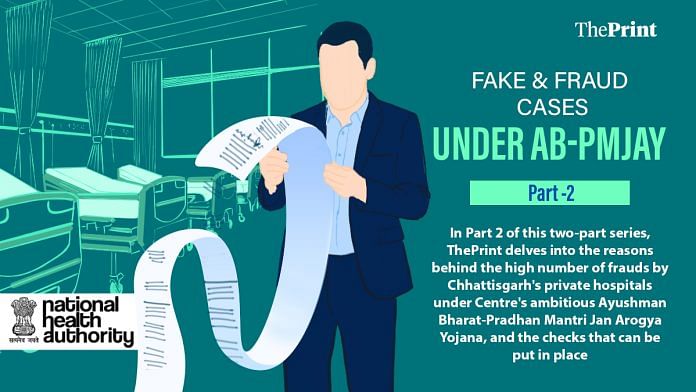The report also noted that the hospital routinely admitted patients requiring intensive care but has no Intensive Care Unit (ICU).
The Shri Shyam hospital was among 23 private hospitals that faced a crackdown, the first-ever on this scale in Chhattisgarh, on charges of misuse and abuse of funds under AB-PMJAY. The health insurance scheme offers free hospital services of up to Rs 5 lakh to the most vulnerable.
The field inspections by the state authorities across 28 private hospitals in Chhattisgarh came after the National Anti-Fraud Unit of the National Health Authority, the central agency implementing AB-PMJAY, informed the state government about suspicious hospitalisations and patterns of possible abuse.

Of hospitals found to be committing fraud, while a majority had 100 or above bed capacities, the hospitals with smaller bed capacities, significantly higher in number, largely drive the AB-PMJAY in Chhattisgarh. The authorities found these small hospitals grossly lacking in basic standards to offer inpatient services, even as several are raising AB-PMJAY claims for different procedures. All the defrauding hospitals, big or small, were either de-empanelled for up to one year or suspended for three or six months.
In Chhattisgarh, AB-PMJAY covers nearly 90 percent of its nearly 3.25 crore population. Those outside the Centre-stipulated eligibility criteria to avail of benefits have a Rs 50,000 coverage, with the state bearing treatment costs entirely. Under this near-universal health coverage based on demand-side financing, small for-profit health facilities were empanelled under AB-PMJAY, without much verification. Later, there was barely any monitoring.
The data accessed from the state health department by ThePrint shows that of 584 hospitals empanelled under AB-PMJAY, a majority, 297, have up to 20 beds, 239 of them have 11-20 beds, and the rest have under 10. A look at total funds used and average admissions under the scheme per year in Chhattisgarh shows the average claim is Rs 10,000, less than the national average of Rs 13,000 per year. This indicates that most patients in Chhattisgarh can use AB-PMJAY only for minor procedures, hinting at the lack of services that are a little complex, as the inspection of small hospitals confirmed.
Some big private hospitals penalised for dual billing and upcoding included Ramakrishna Care Hospital, the SMC Heart hospital, and Agarwal Hospital in Raipur, and Hi-Tech and Sparsh hospitals in Durg, as . Part 1 was on AB-PMJAY fraud cases in Chhattisgarh, which has a high tally of these cases.
The AB-PMJAY covers roughly 55 crore beneficiaries in India, corresponding to 12.37 crore families and constituting 40 percent of Indians at the bottom of the socio-economic structure. Last year, the coverage was extended to citizens above 70, irrespective of income.
Under the NHA guidelines, the state government can empanel all hospitals from community health centres upwards under AB-PMJAY. However, before empanelling private hospitals, states have to conduct verifications. Hospitals should have 10 inpatient beds and meet standards under the scheme to get empanelled.
However, considering underdeveloped or aspirational districts, the NHA allows private hospitals with inpatient capacities of 5-10 beds to get empanelled. Chhattisgarh has 10 districts designated as such. Also, in the cases of private health facilities, empanelling and monitoring responsibilities lie entirely with the state administration.
A public health official, previously associated with the Chhattisgarh State Health Resource Centre (SHRC), tells ThePrint that while the issues in AB-PMJAY implementation remain similar in most states, those with stricter regulatory mechanisms perform better.
SHRC, a think-tank formed in the early 2000s, was a collaboration between civil service organisations and the Chhattisgarh government, tasked with guiding health policies and assessments under various programmes. It was discontinued last year.
“In my years working in Chhattisgarh, the state did not have proper checks and balances for empanelled hospitals, according to my observation. Neither was there a norm of keeping the hospitals in check,” the official says.
For-profit hospitals, hence, can indulge with impunity in practices such as showing ghost patients to seek funds and hospitalising patients unnecessarily. They also illegally draw patients to hospitals through medical camps.
Some of these hospitals do not have MBBS doctors round-the-clock to treat patients. Others show a gross lack of infrastructure required for treatments they promise, as confirmed in the crackdown.
The public health official says neighbouring Madhya Pradesh also logged high fraudulent transactions under AB-PMJAY, but the situation in the state has, of late, improved after it decided to empanel hospitals only with a certain number of specialities, or entry-level certifications on quality service and patient safety standards by the National Accreditation Board of Hospitals and Healthcare Providers.
“We have not been reviewing our empanelled hospitals. We have planned to make it regular now,” Amit Kataria, secretary of health and family welfare and the medical education department, Chhattisgarh, tells ThePrint. Kataria says a robust review mechanism ensures compliance by small hospitals and big players.
Data on hospitals empanelled under AB-PMJAY shows the largest concentrations of private hospitals are in three districts—Raipur, Bilaspur and Durg. Raipur has 206 private hospitals empanelled, 88 of which have up to 20 beds.
Smaller hospitals, mostly for-profit establishments and some of these facilities seem to be doing reasonably good work, lie across the districts with tribal hospitals, including those most impacted by the Naxalite insurgency—Bastar, Kanker, and Kondagaon, among others.
“We know there are certain issues if the small private hospitals are allowed to carry out admissions under the government health insurance scheme, but the idea is also to give access to people to healthcare close to where they stay,” state health minister Shyam Bihari Jaiswal tells ThePrint.
In most underdeveloped districts, he says, there would not be any hospitals at all if the government made the criteria for empanelling hospitals stricter.
“Also, people need immediate medical care for conditions, such as malaria, dengue and enteric fever, which are endemic in many parts of the state,” Jaiswal says. “We are, therefore, now more inclined to put mechanisms in place that prevent misuse and violation of guidelines by hospitals while offering healthcare to people.”
However, Raman V.R., a public health expert, cautions that the quality of medical care is only an outcome of several cumulative inputs. While conditionalities, as part of medical service coverage, can be a component, ensuring their implementation requires “quality” monitoring and troubleshooting of the service quality at different levels and facilities, he tells ThePrint.
“This cannot be done as a post-facto disciplinary action-oriented system but needs a concurrent problem-solving and course-correction approach, applicable both for public and private systems. Penalising approaches on a set of defaulters may be needed, but can not be the central approach,” he underlines.
Raman also says that another important component of quality medical care is the ethical and procedural regulation of services—bringing facilities under different levels of quality standards, introducing and ensuring adherence to standard operating protocols, recognising best quality services regularly, etc.
“Such processes are also much needed in the public sector service provision. Chhattisgarh has a long way to go to ensure all that,” he adds.
Private healthcare providers, however, maintain that low package rates offered under AB-PMJAY are one of the key reasons for rampant financial fraud by hospitals.
“The government has fixed rates, even 20-30 percent lower than those fixed under the Central Government Health Scheme (CGHS). It has made most big private hospitals stay away from the scheme so far,” said Ameera Shah, the president of NAThealth—a network of private players in the healthcare sector.
CGHS covers all current and retired central government employees and their families, and its user base is nearly 42 lakh. Beneficiaries can avail of outpatient and inpatient services in designated hospitals at rates lower than the rates cash-paying patients get charged otherwise.
Asked why some big hospitals indulged in fraud, such as dual billing or upcoding, Shah says that even countries such as the US report medical fraud and unethical practices.
“Onboarding [health care] providers delivering quality service to patients will minimise these issues and lead to better clinical outcomes,” says Dr Alexander Thomas, an adviser with the Association of Healthcare Providers of India, a country-wide group of private hospitals.
Shah points out that there can also be issues with ethics in government hospitals, now that healthcare personnel get incentives for hospital admissions. “But we do not know because there is no data on that out in the public domain,” she adds.
However, Chhattisgarh officials maintain that the incentives ensure the use of more AB-PMJAY funds in the public sector. “The ratio of private to public funds-use earlier was 80:20. It has now changed to 60:20 over the years,” a senior state government official says.
(Edited by Madhurita Goswami)








